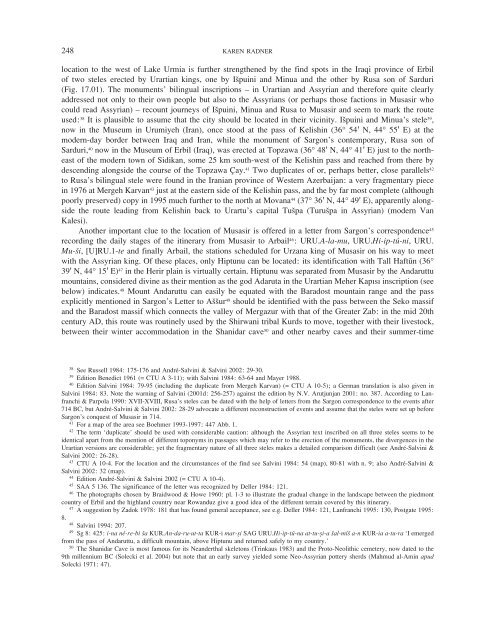Download PDF version of article - UCL
Download PDF version of article - UCL
Download PDF version of article - UCL
Create successful ePaper yourself
Turn your PDF publications into a flip-book with our unique Google optimized e-Paper software.
248 KAREN RADNER<br />
location to the west <strong>of</strong> Lake Urmia is further strengthened by the find spots in the Iraqi province <strong>of</strong> Erbil<br />
<strong>of</strong> two steles erected by Urartian kings, one by Ispuini and Minua and the other by Rusa son <strong>of</strong> Sarduri<br />
(Fig. 17.01). The monuments’ bilingual inscriptions – in Urartian and Assyrian and therefore quite clearly<br />
addressed not only to their own people but also to the Assyrians (or perhaps those factions in Musasir who<br />
could read Assyrian) – recount journeys <strong>of</strong> Ispuini, Minua and Rusa to Musasir and seem to mark the route<br />
used: 38 It is plausible to assume that the city should be located in their vicinity. Ispuini and Minua’s stele 39 ,<br />
now in the Museum in Urumiyeh (Iran), once stood at the pass <strong>of</strong> Kelishin (36° 54b N, 44° 55b E) at the<br />
modern-day border between Iraq and Iran, while the monument <strong>of</strong> Sargon’s contemporary, Rusa son <strong>of</strong><br />
Sarduri, 40 now in the Museum <strong>of</strong> Erbil (Iraq), was erected at Topzawa (36° 48b N, 44° 41b E) just to the northeast<br />
<strong>of</strong> the modern town <strong>of</strong> Sidikan, some 25 km south-west <strong>of</strong> the Kelishin pass and reached from there by<br />
descending alongside the course <strong>of</strong> the Topzawa Çay. 41 Two duplicates <strong>of</strong> or, perhaps better, close parallels 42<br />
to Rusa’s bilingual stele were found in the Iranian province <strong>of</strong> Western Azerbaijan: a very fragmentary piece<br />
in 1976 at Mergeh Karvan 43 just at the eastern side <strong>of</strong> the Kelishin pass, and the by far most complete (although<br />
poorly preserved) copy in 1995 much further to the north at Movana 44 (37° 36b N, 44° 49b E), apparently alongside<br />
the route leading from Kelishin back to Urartu’s capital Tuspa (Turuspa in Assyrian) (modern Van<br />
Kalesi).<br />
Another important clue to the location <strong>of</strong> Musasir is <strong>of</strong>fered in a letter from Sargon’s correspondence 45<br />
recording the daily stages <strong>of</strong> the itinerary from Musasir to Arbail 46 : URU.A-la-mu, URU.Hi-ip-tú-ni, URU.<br />
Mu-si, [U]RU.1-te and finally Arbail, the stations scheduled for Urzana king <strong>of</strong> Musasir on his way to meet<br />
with the Assyrian king. Of these places, only Hiptunu can be located: its identification with Tall Haftun (36°<br />
39b N, 44° 15b E) 47 in the Herir plain is virtually certain. Hiptunu was separated from Musasir by the Andaruttu<br />
mountains, considered divine as their mention as the god Adaruta in the Urartian Meher Kapısı inscription (see<br />
below) indicates. 48 Mount Andaruttu can easily be equated with the Baradost mountain range and the pass<br />
explicitly mentioned in Sargon’s Letter to Assur 49 should be identified with the pass between the Seko massif<br />
and the Baradost massif which connects the valley <strong>of</strong> Mergazur with that <strong>of</strong> the Greater Zab: in the mid 20th<br />
century AD, this route was routinely used by the Shirwani tribal Kurds to move, together with their livestock,<br />
between their winter accommodation in the Shanidar cave 50 and other nearby caves and their summer-time<br />
38 See Russell 1984: 175-176 and André-Salvini & Salvini 2002: 29-30.<br />
39 Edition Benedict 1961 (= CTU A 3-11); with Salvini 1984: 63-64 and Mayer 1988.<br />
40 Edition Salvini 1984: 79-95 (including the duplicate from Mergeh Karvan) (= CTU A 10-5); a German translation is also given in<br />
Salvini 1984: 83. Note the warning <strong>of</strong> Salvini (2001d: 256-257) against the edition by N.V. Arutjunjan 2001: no. 387. According to Lanfranchi<br />
& Parpola 1990: XVII-XVIII, Rusa’s steles can be dated with the help <strong>of</strong> letters from the Sargon correspondence to the events after<br />
714 BC, but André-Salvini & Salvini 2002: 28-29 advocate a different reconstruction <strong>of</strong> events and assume that the steles were set up before<br />
Sargon’s conquest <strong>of</strong> Musasir in 714.<br />
41 For a map <strong>of</strong> the area see Boehmer 1993-1997: 447 Abb. 1.<br />
42 The term ‘duplicate’ should be used with considerable caution: although the Assyrian text inscribed on all three steles seems to be<br />
identical apart from the mention <strong>of</strong> different toponyms in passages which may refer to the erection <strong>of</strong> the monuments, the divergences in the<br />
Urartian <strong>version</strong>s are considerable; yet the fragmentary nature <strong>of</strong> all three steles makes a detailed comparison difficult (see André-Salvini &<br />
Salvini 2002: 26-28).<br />
43 CTU A 10-4. For the location and the circumstances <strong>of</strong> the find see Salvini 1984: 54 (map), 80-81 with n. 9; also André-Salvini &<br />
Salvini 2002: 32 (map).<br />
44 Edition André-Salvini & Salvini 2002 (= CTU A 10-4).<br />
45 SAA 5 136. The significance <strong>of</strong> the letter was recognized by Deller 1984: 121.<br />
46 The photographs chosen by Braidwood & Howe 1960: pl. 1-3 to illustrate the gradual change in the landscape between the piedmont<br />
country <strong>of</strong> Erbil and the highland country near Rowanduz give a good idea <strong>of</strong> the different terrain covered by this itinerary.<br />
47 A suggestion by Zadok 1978: 181 that has found general acceptance, see e.g. Deller 1984: 121, Lanfranchi 1995: 130, Postgate 1995:<br />
8.<br />
48 Salvini 1994: 207.<br />
49 Sg 8: 425: i-na né-re-bi sa KUR.An-da-ru-ut-ta KUR-i mar-Òi SAG URU.Hi-ip-tú-na at-tu-Òi-a sal-mís a-n KUR-ia a-tu-ra ‘I emerged<br />
from the pass <strong>of</strong> Andaruttu, a difficult mountain, above Hiptunu and returned safely to my country.’<br />
50 The Shanidar Cave is most famous for its Neanderthal skeletons (Trinkaus 1983) and the Proto-Neolithic cemetery, now dated to the<br />
9th millennium BC (Solecki et al. 2004) but note that an early survey yielded some Neo-Assyrian pottery sherds (Mahmud al-Amin apud<br />
Solecki 1971: 47).

















